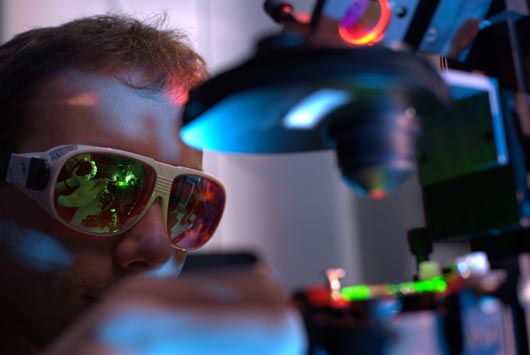Healing with light

Doctors and scientists need to work closer together, according to a new international group working at the forefront of the use of light in medicine.
The experts say that the bringing together of disparate groups in science and medicine is the only way to ensure rapid applications from the lab to the medical theatre.
In a major meeting at the University of St Andrews tomorrow (12 May 2010), around 100 key experts from Europe will outline what they can do to improve the speed of new developments at the cutting edge of healthcare, thus paving the most efficient way of tackling emerging healthcare threats.
New applications involving the use of light in early cancer detection, dentistry, immunology, and Alzheimer’s will be outlined during the one day event.
The event is led by Photonics4Life, an EU-funded consortium involving 21 partner institutions, formed to establish better working relationships between the disparate groups in science and medicine.
The University of St Andrews is the only Scottish institution involved in the pan-European body. Speaking in advance of the event, organiser Professor Kishan Dholakia said, “Imagine medicine today without x-rays or microscopes – inventions all made by physicists long ago. In the twenty-first century the rise of cancer, heart diseases, AIDS, and emerging pandemic threats pose new and staggering challenges to the medical community.
“A major challenge is to ensure that cutting edge developments in the diverse and separate fields of physics, engineering, chemistry, and biology are rapidly applied to the medical theatre. We believe bringing together the disparate groups of science and medicine to be the most efficient way to tackle emerging healthcare threats.”
In the field of biophotonics, light-based technologies are applied to problems in medicine and life sciences. This week’s event will bring together medical professionals, specialising in cancer, Alzheimer’s disease, and immunology to engage directly with laser physicists, lab-on-a-chip technologists, and advanced microscopists. The group aims to tackle new collaborative efforts under the banner of understanding, diagnosing, and treating emerging healthcare needs.
The event will include talks by leading experts from St Andrews, Professors Kishan Dholakia Simon Herrington and Frank Gunn-Moore, and Dr Simon Powis.
Professor Jürgen Popp, co-ordinator of the Photonics4Life network, added, “Affordable and effective healthcare would ideally be available to all of mankind and hence it is more important than ever that the scientific and medical communities unite in their efforts.”
ENDS
Note to editors:
Media are welcome to attend the event. Contact the Press Office (details below) for a full timetable.
For further information or to arrange interviews in advance, contact David Stevenson on 01334 461653 / 07811 192 687. Tours of lab facilities can be arranged for broadcast media / photographers.
Note to picture editors:
Laser-related images are available from the Press Office contacts below.
The scientists will gather for a group photograph at 13.45 on Wednesday 12 May outside the School of Physics and Astronomy, North Haugh, St Andrews. You are invited to attend.
Issued by the Press Office, University of St Andrews
Contact Gayle Cook, Senior Communications Manager on 01334 467227 / 462529, mobile 07900 050 103, or email [email protected]
Ref: Healing with light 110510
View the latest University press releases at www.st-andrews.ac.uk
Category Research